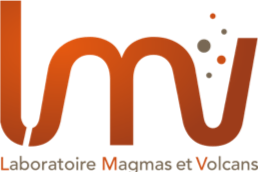Directrice de recherches, CNRS
Equipe volcanologie
Bureau 1.44, Téléphone: 04.73.34.67.87, mail : valerie.cayol@uca.fr
Responsable de l’équipe volcanologie, HDR
2 enfants
-
Thèmes de recherches principaux :
- Développement de méthodes numériques 3D pour l’analyse des déformations des volcans;
- Étude du transfert et du stockage du magma;
- Étude des mouvements de flanc des édifices volcaniques: analyse des déplacements InSAR et lien avec la friction;
- Combinaison des inversions de déformations aux inversion de taux de sismicité pour des failles dont la friction suit les lois « rate and state »;
- Inversion conjointes de données de muographie et de gravimétrie.
Développement de méthodes numériques 3D pour l’analyse des déformations des volcans (voir page you tube epos-France)
Afin de calculer rapidement les déformations et les contraintes associées à des fractures en milieu élastique homogène et isotrope, tout en prenant en compte les topographies réalistes, j’ai combiné deux méthodes d’éléments frontières (Cayol et Cornet, IJRMMS, 1997, JGR, 1998). On utilise ces méthodes numériques dans des inversions, ce qui consiste à déterminer les sources qui minimisent l’écart entre déplacements du sol observés et résultats des simulations. Les sources considérées peuvent correspondre à des réservoirs, des intrusions planaires ou des failles (Fukushima et al., JGR, 2005). Pour plus d’information sur la méthode, voir la page volcanologie-numérique. Cette méthode est disponible sur le lien DefVolc. Pour obtenir un compte, veuillez me contacter.
Deux videos présentent DefVolc, la première présente l’interface web et la seconde présente le pré- et post-processeur (en anglais).
Avec mes collègues du département de mathématiques, nous (enfin surtout eux) avons aussi développé une méthode de domaines fictifs permettant la prise en compte des hétérogénéités et anisotropies (Bodart et al., SIAM, JSC, 2016). Cette méthode a été utilisée afin de développer des inversions de contraintes sur des fractures de géométrie supposée connue (Bodart et al., Computational Geosciences, 2022).
Influence de la topographie sur le signal de déformation induit par une source sphérique L’interférogramme de l’Etna pour la période 1992-1993 (a) indique une déflation qui peut être en partie modélisée par une source sphérique située sous un volcan proéminent (c). Lorsqu’on modélise cette déformation en négligeant la topographie (b), le signal de déformation est moins bien expliqué (Cayol et Cornet, GRL, 1998).

Méthode de Cluster pour la détermination des sources sans a-priori sur leur géométrie Des tests synthétiques sont effectués dans lesquels un modèle généré par éléments frontières (maillages à gauche) est inversé par la méthode de cluster (images au centre). Ici différentes géométrie de sources sont superposées. La méthode permet de retrouver correctement les géométries de sources (Thèse A. Augier).
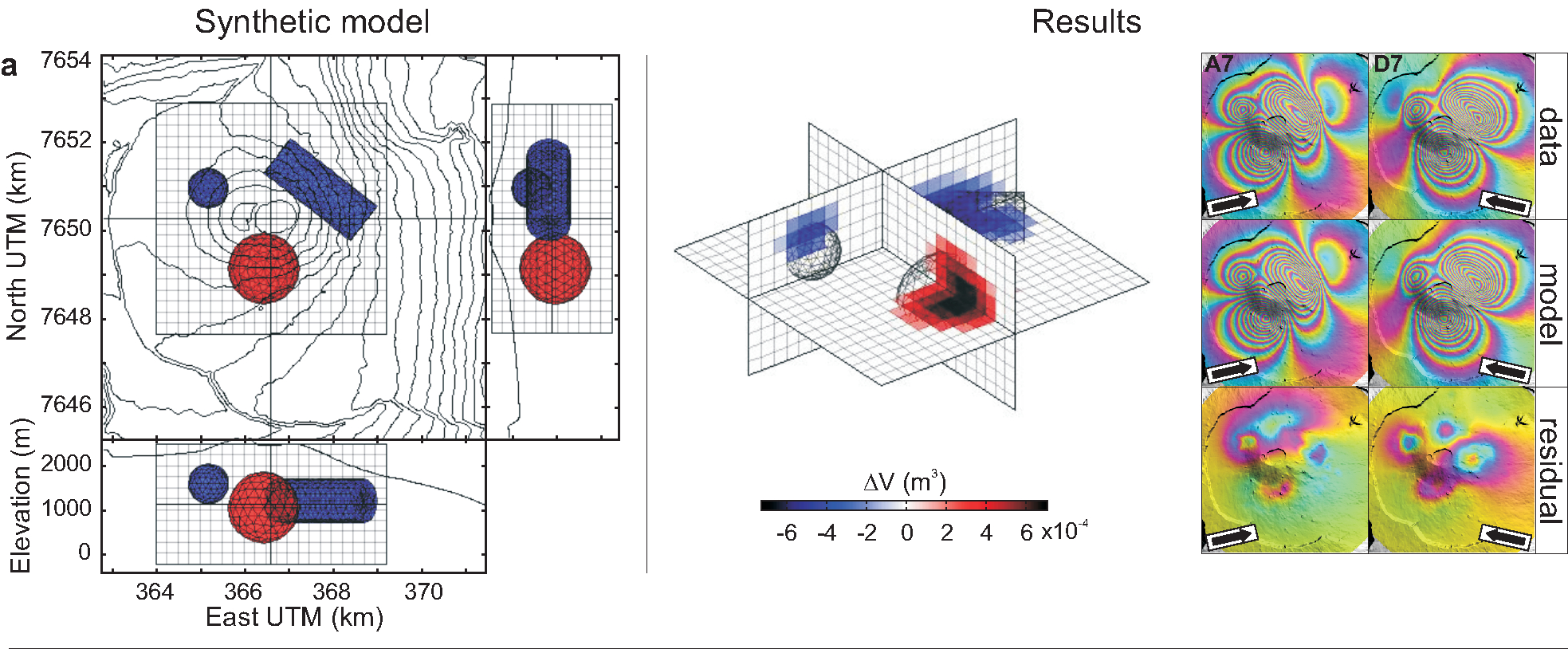
Étude du transfert et du stockage du magma
Ces méthodes ont été appliquées au Piton de la Fournaise et sur les volcans du Nyiragongo et Nyamuragira afin d’étudier la façon dont le magma s’injecte dans les édifices.
Modèles pour les éruptions du Piton de la Fournaise survenues entre mars 1998 et juin 2000 Ces modèles sont obtenus par l’analyse de données RADARSAT-1 grâce à des modélisations éléments frontières combinées à des inversions de type proches voisins (Fukushima et al., JGR, 2005). Ces modèles correspondent à des dikes superficiels, allongés horizontalement et qui suivent la topographies. Ils sont situés au dessus de l’essaim sismique pré-éruptif (Fukushima et al., JGR, 2010).
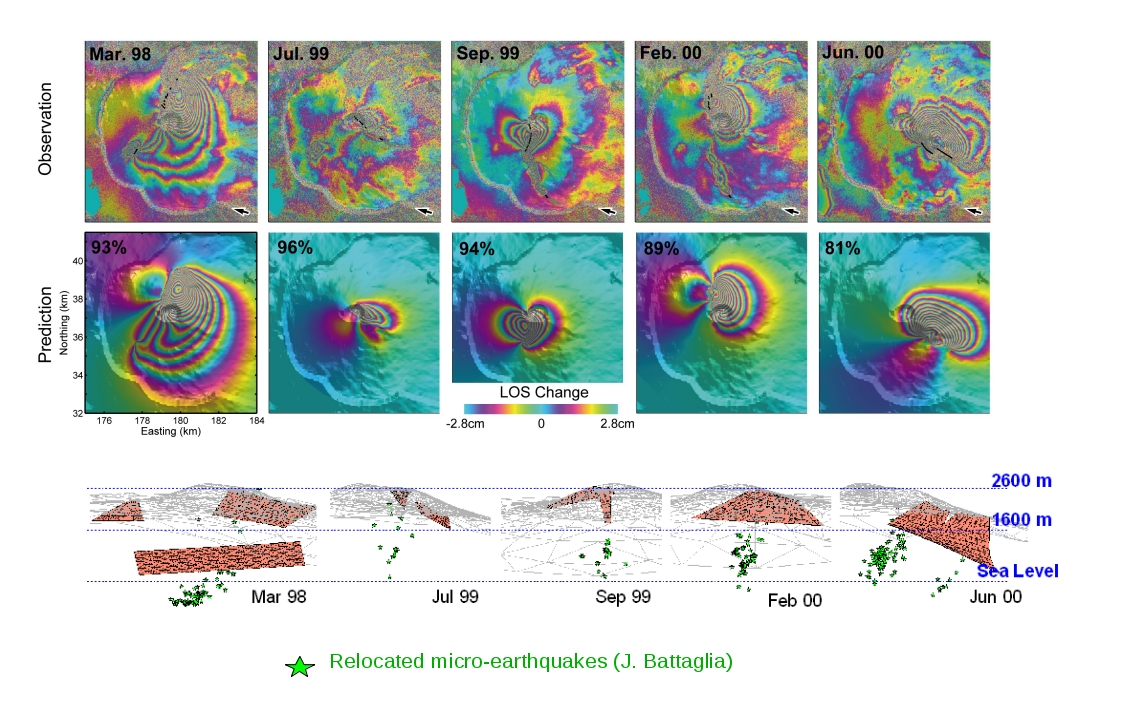
Modèles pour l’éruption de janvier 2002 au Nyiragongo (RDC) Les inversions montrent que l’éruption correspond à deux dikes : l’un, lié à la fissure éruptive, est superficiel, l’autre, qui s’étend sous le lac Kivu sur 20 km, s’est arrêté à 2 km sous la surface (Wauthier et al., JGR, 2012).
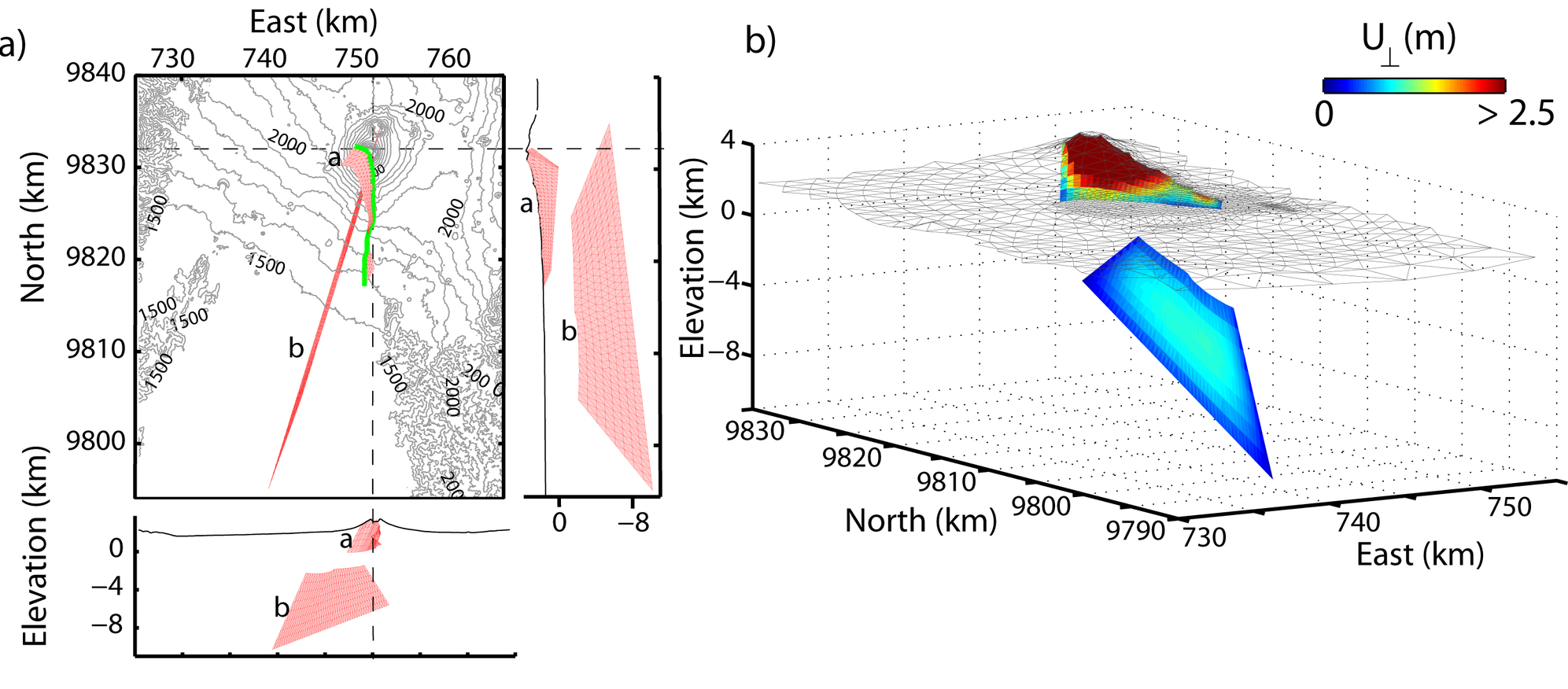
Modèles pour l’éruption de 2010 au Nyamulagira (RDC) Pour cette éruption, le volume émis est 10 fois supérieur à la déflation du réservoir, ce qui peut s’expliquer par la compressibilité du magma, contenant 0.1wt% de CO2 (Wauthier et al., Remote Sensing, 2015)

Propagation du magma lors de l’éruption du Piton de la Fournaise de mai 2016 Les données InSAR et GNSS continues ont été inversées simultanément afin de déterminer comment le magma se propage depuis sa source vers la surface (voir Smittarello et al., Remote Sensing, 2019 pour la méthode). Nous avons déterminé que la propagation se faisait par à-coups avec une phase d’accélération et une pause avant la mise en place d’un dike final. Le volume de magma contenu dans l’intrusion et émis en surface résulte probablement d’un seul apport survenu en début d’éruption. La phase finale de la propagation pourrait résulter de la diminution de contraintes liés à une glissement de flanc est ou de la pression exercée par les gaz accumulés en haut du sill (Smittarello et al., JGR, 2019).
Étude des mouvements de flanc des édifices volcaniques
Des modélisations ont été menées au Kilauea, à l’île de la réunion (Piton des neiges et sur le Piton de la Fournaise) afin de comprendre la conséquence des intrusions de magma sur la stabilité des édifices.
Contraintes de Coulomb induites par l’ouverture des rift zones du Kilauea, lesquelles sont couplées à un glissement sur le décollement du flanc sud du volcan. Ce modèle a été établi à partir des déformations du volcan mesurées par distancemétrie entre 1976 et 1983. Il montre que la sismicité est située sur la partie du décollement qui est bloquée (Cayol et al., Science, 2000).
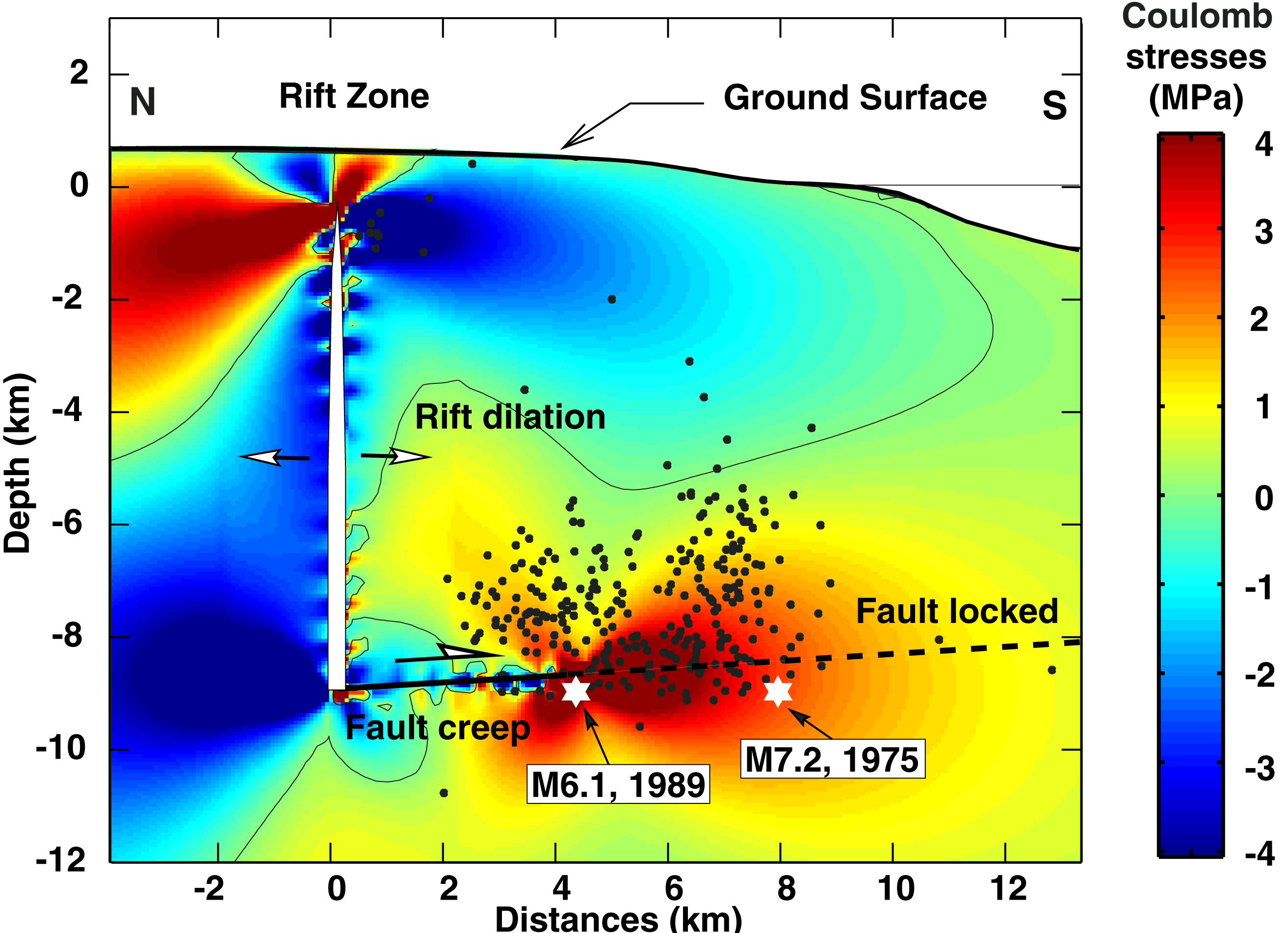
Déplacements induits par des injections de sills, éventuellement cisaillées et par des failles. Cette étude compare les déplacements internes et les déplacements à la surface du sol engendrés par toute une variété de fractures, que ce soient des intrusions, des intrusions cisaillées ou des failles. Il est supposé que, lorsque les fractures ne se mettent pas en place perpendiculairement à σ3, elles se cisaillent sous l’effet de la gravité (σ1). Ce cas peut se produire si les fractures sont guidées par des discontinuités pré-existantes. Comme le magma annule la friction, les intrusions relâchent les contraintes cisaillantes, de la même façon qu’un faille de friction nulle. Ici k =σ3/σ1 = 0.6 (Cayol et al., JGR, 2014).
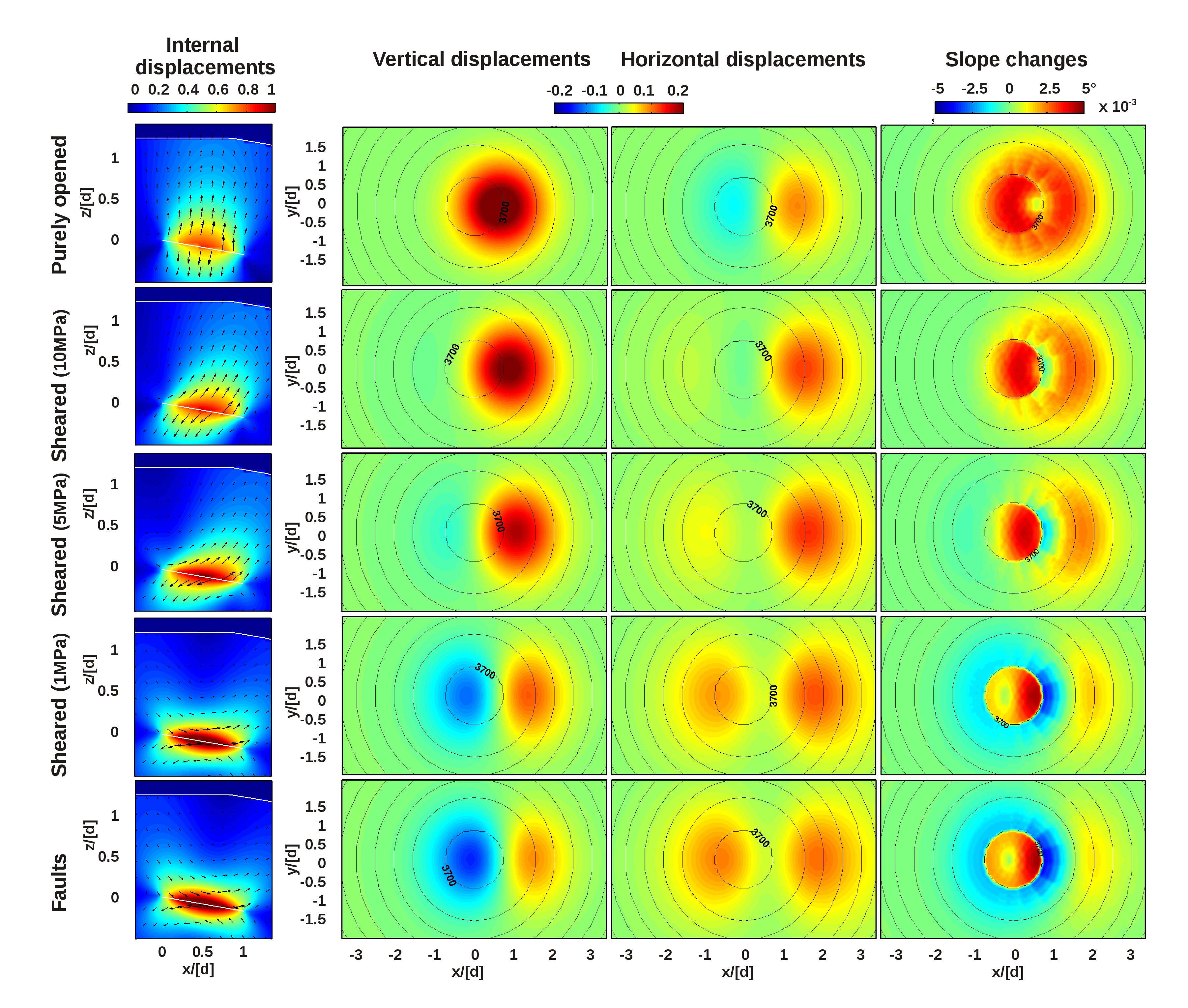
Inversion du déplacements de flanc survenus lors de l’éruption d’avril 2007 au Piton de la Fournaise. L’éruption d’avril 2007 a été exceptionnelle à plusieurs égards : les volumes de lave émis ont été les plus importants du XX et XXI siècle (240 x 106 m3), un effondrement de la caldera sommitale de 340 m s’est produit, ainsi qu’un glissement de flanc de 1.4 m vers l’est. Cette étude vise à comprendre l’origine du glissement de flanc est. Le modèle le plus communément admis pour les glissements de flancs de volcans est qu’ils résultent de mouvements sur des failles déclenchées par la répétition d’intrusions de magmas. Récemment, un autre modèle de glissement de flanc a été suggéré par des études de géologie structurale au Piton des Neiges (Famin et al., 2010; Chaput et al., 2014), le voisin éteint du Piton de la Fournaise. Dans ce modèle, les glissements de flancs seraient induits par la mise en place d’intrusions le long de discontinuités pré-existantes, de telles sortes que les intrusions subissent un cisaillement, similaire à celui induit sur des failles. L’étude des déplacements de flancs postérieurs à 2007 montre que ceux ci résultent de la compaction et du cisaillement d’une fracture parallèle à la topographie, située à 500 m sous la surface du sol. Néanmoins, nous trouvons que la contraction est trop importante pour être attribuée à un sill, et semble plutôt liée à la compaction d’un pli en détachement probablement situé à l’interface entre d’anciennes coulées (Tridon et al., JGR, 2016).
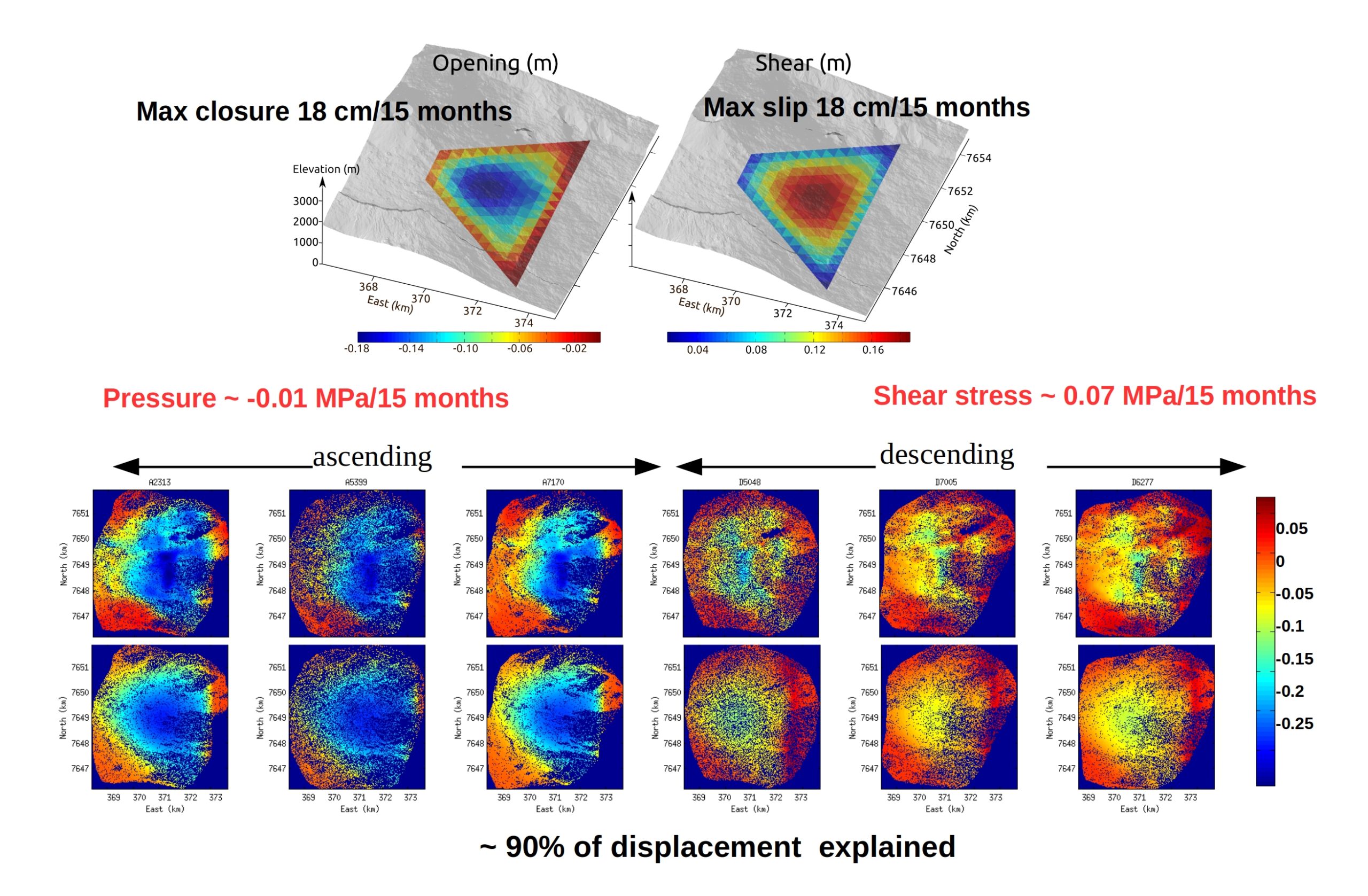
Un mécanisme de glissement de flanc inédit révélé par l’interférométrie radar. En interprétant, par des simulations numériques, les 57 éruptions imagées entre 1998 et 2020, nous avons montré que la plupart des fractures magmatiques sont guidées par une structure majeure en forme de cuillère, ouverte vers la mer. Cette structure est connectée, en surface, à des zones d’intrusions préférentielles bien connues sur le terrain. L’étude révèle un mécanisme de glissement inédit, caractérisé par un continuum allant de l’ouverture au glissement pur. Lorsque le magma s’injecte dans la partie verticale de la structure, il l’ouvre, mais lorsqu’il force son passage dans la partie horizontale, celle-ci coulisse et entraîne avec elle l’ensemble du flanc vers la mer. Cette structure se termine par une faille sismique, activée lors d’une éruption en 2007, mais qui est pour l’instant bloquée. A l’échelle des temps géologiques, des injections de magma répétées dans ce type de structure pourraient conduire à des séismes importants ou à des effondrements catastrophiques des flancs (Dumont et al., Nature Communications, 2022). Voir aussi la communications CNRS « Un mécanisme de glissement de flanc inédit révélé par interférométrie radar« .
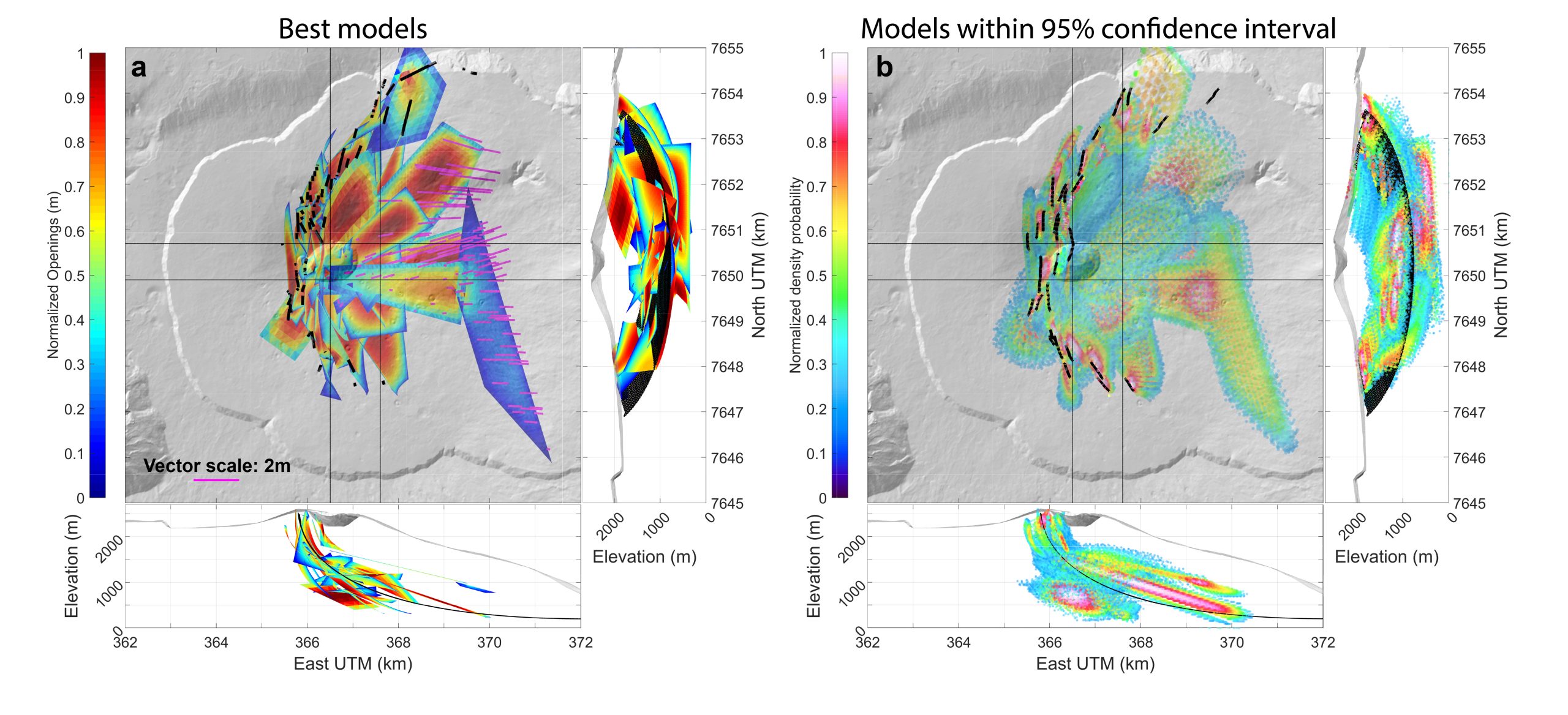
Combinaison des inversions de déformation avec les inversions de taux sismiques pour les failles dont la friction suit des lois « Rate and state »
Modèle pour les éruptions du Kilauea de 1983 et 1977. En comparant les contraintes de Coulomb correspondant à des calculs numériques par éléments frontières (A et B) et des inversions utilisant les taux de sismicité (C et D), nous avons validé la possibilité d’utiliser les taux de sismicité pour déterminer les variations de contraintes en profondeur et nous avons trouvé que ces éruptions correspondaient à la propagation verticale d’un dike issu des rift-zones (B), plutôt qu’à la propagation horizontale d’un dike issu du sommet du volcan (A) (Dieterich et al., Nature, 2000; Dieterich et al., USGS Prof. Pap., 2003).

Inversion conjointes de données de muographie et de gravimétrie
Les données de gravimétrie comme de muographie permettent de déterminer les densités crustales. Néanmoins, les inversions de ces données sont des problèmes inverses linéaires mal-posés. En combinant gravimétrie et muographie, on améliore les déterminations de densités. Néanmoins, les inversions dépendent d’hyperparamètres (une variance sur la densité a priori, σρ, et une distance caractéristique de lissage, λ), qui sont le plus souvent déterminés de façon ad-hoc ou en référence à un cas test unique. Ces hyperparamètres ont une influence cruciale sur les densités retrouvées et leur mauvaise estimation peut conduire à des artefacts. En outre les densités imagées par gravimétrie et muographie diffèrent souvent d’une constante. Nos études, basées sur un formalisme Bayesien, ont visé à mettre au point des méthodes robuste de détermination des hyperparamètres (Barnoud et al., GJI, 2019) et du décalage entre densités imagées (Lelièvre et al., GJI, 2019). Pour cela des tests ont été effectués sur un volcan fictif dont la géométrie est proche du Puy de Dôme. Ces méthodes ont ensuite été appliquées au puy de Dôme (Barnoud et al., Frontiers In Earth Sciences, 2021). Voir la communication CNRS « Voyage au centre du puy de Dôme« .
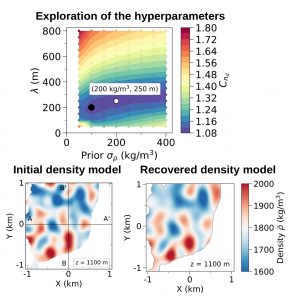 La méthode la plus robuste pour la détermination des hyperparamètres est celle du Leave-One-Out. Elle consiste déterminer les paramètres quipermettent de mieux retrouver les observations en des points omis dans l’inversion. Le minimum de ce critère (point blanc sur la figure du haut) correspond bien à un modèle proche du modèle initial (figures du bas) (adapté de Barnoud et al., GJI, 2019)
La méthode la plus robuste pour la détermination des hyperparamètres est celle du Leave-One-Out. Elle consiste déterminer les paramètres quipermettent de mieux retrouver les observations en des points omis dans l’inversion. Le minimum de ce critère (point blanc sur la figure du haut) correspond bien à un modèle proche du modèle initial (figures du bas) (adapté de Barnoud et al., GJI, 2019)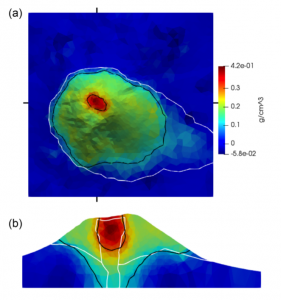 Le décalage déterminé par moindres carrés linéaires donne les modèle inverse très proche du modèle initial. Les discontinuités de densités de ce modèle sont représentées par les lignes blanches (de (Lelièvre et al., GJI, 2019)
Le décalage déterminé par moindres carrés linéaires donne les modèle inverse très proche du modèle initial. Les discontinuités de densités de ce modèle sont représentées par les lignes blanches (de (Lelièvre et al., GJI, 2019)Volcans étudiés :
Piton de la Fournaise (Ile de la Réunion France), Nyiragongo et Nyamulagira (République Democratique du Congo), Kilauea (Hawaii, U.S.A.), La Soufriere (Montserrat, Antilles), Karthala (Grande Comore), Etna (Sicile, Italie).
-
Encadrements :
- 6 Post-doctorants : N. Fournier (2004, European), P. Tinard (2008-2009, CNES), S. Court (2013-2015, Clervolc LaBeX), N. Le Corvec (2016-2018, Clervolc LaBeX), A. Barnoud (2016-2020, ClerVolc LaBex, CNES),
- F. Dabaghi (2016-actuel, Clervolc LaBex, CNES, ClerVolc, Institut des Mathématiques pour la Planète Terre, ANR)
- Co-direction de 10 thèses : F. Ranvier (1999-2003), Y. Fukushima (2002-2005), P. Tinard (2004-2007), C. Wauthier, (2007-2011), A. Augier (2008-2011), T. Catry (2009-2011), M. Tridon (2012-), D. Smittarello (2016-2019), Q. Dumont (2018-2022), prix de thèse de géophysique du CNFGG en 2023, M. Colevita (2021-actuel)
- Participation ponctuelle à 5 thèses : O. Roche (1998-1999), D. Green (2005-2006), A. Hrysiewicz (2016-2019), T. Shreve (2018-2020), A. Iozzia (2022-actuel).
- 8 étudiants en master du LMV (P. Tinard, L. Gailler, C. Wauthier., F. Albino, A. Augier, S. Menassian, Q. Dumont, A. Hautecoeur), un étudiant en master au LIMOS (A. Kouassi), une étudiante en master de l’Université du Chili (D. Parra), 5 étudiants en stage ingénieur, un étudiant en IUT informatique.
Responsabilités scientifiques :
Actuelles :
- 2024-actuel : Responsable adjointe de l’équipe volcanologie;
- 2020-2023 : Responsable de l’équipe volcanologie;
- 2019-present : Membre du conseil consultatif du Center for the Observation and Modelling of Earthquakes, Volcanoes and Tectonics (COMET)
- 2019-actuel : Membre du Comité d’Organisation du laboratoire d’excellence ClerVolc. Responsable de l’axe 2 structure interne et déformation des édifices volcaniques.
Passées :
- 2018-2022 : membre élu du conseil Scientifique de l’Observatoire de Physique du Globe de Clermont-Ferrand.
- 2007-2016 : Membre pour la Région Auvergne du conseil scientifique de Vulcania (St Ours).
- 2011-2016 : Responsable de la commission informatique du Laboratoire Magmas et Volcans.
- 1999-2003 : Membre du conseil de laboratoire du Laboratoire Magmas et Volcans.
Projets de recherche :
- 2024-2027 : ANR DGMod (Coordinatrice, co-coordinateurs avec O. Bodart et P.-H. Cocquet), « Towards a new generation of joint InSAR – gravity inversions »;
- 2022-2023 : Institut des Mathématiques pour la Planète Terre (IMPT) (Co-coordinatrice, Coordinateur O. Bodart) « Développement d’une méthode de modélisation conjointe dés déplacements et des variations de gravité »;
- 2021-2022 : ClerVolc LaBeX (Coordinatrice, co-coordinateurs O. Bodart et J. Koko), « Utilisation de domaines fictifs pour des sources de déformation multiples dans un domaine élastique »;
- 2020 : INSU-ALEAS and ClerVolc LaBeX (Coordinatrice), “Influence des intrusions sur la stabilité du flanc oriental du Piton de la Fournaise”;
- 2019 : PNTS (Co-coordinatrice, coordinatrice A. Barnoud) “Inversion et modélisation conjointes des changements de déformation et de gravité associés aux éruptions volcaniques du volcan du Piton de la Fournaise »;
- 2018-2021 : H2020 Integrating and opening infrastructures of European Interest (Participante), « European Network of Observatories and Research Infrastructures for Volcanology »;
- 2017-2018 : Campus France avec le German Center for Geosciences GFZ, Postdam, allemagne (programme Procope), (Co-coordinatrice, coordinatrices Virginie Pinel et Eleonora Rivalta) “Modélisation du transport du magma à travers la croûte;
- 2016-2018 : Clervolc (Co-cordinatrice, coordinatrice C. Carloganu) « Inversion conjointe de données de muographie et gravimétrie;
- 2016-2018 : LaBeX Clervolc (Co-coordinatrice, coordinateur O. Bodart et J. Koko), « Modélisation réaliste et inversion des déformations de fractures en contexte volcanique »;
- 2016 : INSU Aleas (coordinatrice), “Suivi de la propagation des intrusions basaltiques par l’inversion des données de déformation au volcan du Piton de la Fournaise”;
- 2013 : INSU Aleas (cooordinatrice), “Déplacement de flancs associé à l’éruption du Piton de la Founaise en 2007;
- 2013-2015 : LaBeX Clervolc (Co-coordinatrice avec O. Bodart et J. Koko), « Domaines fictifs pour la modélisation des intrusions de magma »;
- 2007-2009 : ANR Volcarisk (Co-coordinatrice, coordinateur O. Merle) “Évaluation de l’aléa sur un volcan de point chaud dans l’océan Indien, l’île de la Réunion”;
- 2005-2007 Programme National deTélédétection Spatiale (PNTS) (Co-coordinatrice, coordinateur J.L. Froger), “Vers un suivi opérationnel de l’activité volcanique. Exemple du Piton de la Fournaise;
- 2001-2004 : Projet Européen (Co-coordinatrice, coordinateur J. Neuberg), Multi-Disciplinary monitoring, Modelling and Forecasting of Volcanic Hazard;
- 1999-2001 : INSU PNRN « Risque de déplacement des flancs au Piton de la Fournaise à partir d’une approche structurelle, numérique et analogique ».
Organisation de conférences :
- 2019 : membre du comité scientifique de la conférence MDIS-Form@ter, La Petite Pierre.
- 2017 : Co-organisatrice (avec J.L. Froger) de la conférence MDIS-Form@ter, Besse-en-Chandesse.
- 2015 : Membre du comité d’organisation de la conférence GeoMod, Montpellier.
- 2015 : Membre du comité scientifique du workshop MDIS ForM@Ter (Deformation measurement by space imagery), Autrans.
- 2012 : Membre du comité de programmation de la conférence Chapman de l’AGU « Hawaiian volcanoes, from source to surface« , Hawaii.
- 2011: Membre du comité scientifique de l’école de printemps des Houches “Extraction and Fusion of Information for Displacement measurement from SAR Imagery”, Les Houches.
- 2001-2004 : organisatrice des séminaires du Laboratoire Magmas et Volcans.
Activités d’évaluations :
- 2017- 2023 : membre du comité scientifique des appels à projets CNRS-INSU TelluS-ALEA, devenu CNRS-INSU TelluS-SYSTER en 2022
- 2018-2019 : Participation au comité de sélection de la fondation Fulbright pour les sciences exactes et appliqués, les sciences de la vie et de la terre. Évaluation de projets chercheurs et étudiants.
- 2001 and 2012: membre du jury permanent d’évaluation des stages de Master 2 at LMV.
- 2012-2015 : Comité de direction pour le projet du “Belgium Federal Science Policy Office (Belspo)” sur l’observation de la terre VI-X : Study and monitoring of Virunga volcanoes using Tandem-X.
- Membres de comités de recrutement à IsTerre Université de Savoie (2010), à l’Institut de physique du Globe de Paris (2019), Université de Loraine, CRPG, Nancy (2021).
- Evaluations d’articles pour Nature Geoscience, Tectonophysics, Journal of Geophysical Research, Geophysical research Letter, Journal of Volcanology and Geothermal Research, Physics of the Earth and Planetary Interior, Bulletin of Volcanology.
- Evaluations de projets de la U.S. National Science Fundation (NSF); Icelandic Research Fund; Observatoire des Sciences de l’Univers de Grenoble (OSUG); pour l’Instituto Nazionale di Geofisica E Vulcanologica (INGV), Italie; ERC Advanced.
Jury de thèses :
- En tant qu’examinatrice : Aline Peltier à l’université de la Réunion (juillet 2008); Paola Traversa à IsTerre, Université Joseph Fourier à Grenoble (october 2009); Fabien Albino à IsTerre, Université de Savoie, Chambery (Jan. 2011); Andrew Toombs à l’University of Reading (June, 2011); Aline Schmid à IsTerre, Université Joseph Fourier à Grenoble (Oct. 2011); Anne Obermann à Isterre, Université Joseph Fourier à Grenoble, (Nov. 2013); Cyril Journeau, IsTerre, Université Grenoble Alpes (Sept., 2022); Angèle Laurent, Institut de Physique du Globe de Paris (Avril, 2023); Francesco Bagnioli, Institut de Physique du Globe de Paris (Décembre 2024).
- En tant que rapporteure : Timothy Davis, Institute of Earth and Environmental Science, GFZ, Postdam, Germany (mai, 2021); Camilla Novoa, Laboratoire Geosciences Environnement Toulouse,Toulouse (Juin, 2021); Raphael Bajou, Institut de Physique du Globe de Paris (Juin, 2023); Nicolas Mercury, Institut Terre et Environnement, Université de Strasbourg (Décembre, 2023); Pierre Boymond, Institut de Physique du Globe de Paris (Avril, 2024); Shan Grémion, Université Savoie Mont-Blanc (Novembre, 2024); Alexandra Le Contellec, Ecole Normale Supérieure de Lyon (Décembre 2024).
Jurys d’Habilitation à Diriger des Recherches
- Béatrice Puysségur, Ecole Normale Supérieure de Paris Saclay (Décembre 2024).
Distinctions :
- 2016-2017 : Bourse chercheur Fulbright de 6 mois pour le Cascade Volcano Observatory;
- 2020 : Citation pour l’Excellence d’une Review à Geophysical Research Letter;
-
- Disciplines : modélisation numérique, mécanique des roches, géophysique.
- Modules : Etudes de cas : la Réunion; Geomécanique; méthodologie scientifique, surveillance.
- Niveau : Master 1, Master 2.
-
Collaborations :
- Laboratoire de Mathématiques de l’Institut Camille Jourdan à St Etienne, dans le cadre de projets laboratoire d’excellence Clervolc, de l’Institut des Mathématiques pour la Planète Terre (IMPT) ou de l’ANR
- laboratoire de Mathématiques (LM) et Laboratoire d’Informatique, Modélisation et Optimisation des Systèmes (LIMOS), Laboratoire de Physique Corpusculaire (LPC) de l’Université B. Pascal dans le cadre du laboratoire d’excellence Clervolc.
- IsTerre, Université de Savoie, Le-Bourget-du-Lac
- Université de la Réunion, IPGP.
- Royal Museum for central Africa, Tervuren, Belgium.
- National Museum of Natural History, Walferdange, Luxembourg
- Research Center for Earthquake Prediction, Disaster Prevention Research Institute, Kyoto University, Japan.
- The Pennsylvania State University, Etats-Unis
- UC Riverside, Etats-Unis.
- Cascade Volcano Observatory, U.S.G.S.
- Istituto Nazionale di Geofisica e Vulcanologia, Catania, Italie
Séjours dans des laboratoire à l’étranger :
- 2016-2017: Séjour au Cascade Volcano Observatory de l’U.S. Geological Survey, bourse chercheur Fulbright
- 1996-1997: Post-Doctorat à l’U.S. Geological Survey de Menlo Park, Californie, U.S.A. Sujet : Inversion conjointe de la sismicité et des déformations pour déterminer des variations de contraintes – L’éruption de 1983 du Kilauea (Hawaï).
Publications LMV depuis 2010 :
Rang A
- Boudoire G., Gailler L., Battaglia J., Beauger A., Bontemps M., Bosse V., Breton V., Briot D., Cacault P., Cayol V., Cluzel N., Delage E., del Campo G., Deniel C., Devidal J.L., Douchain J.M., Faissal A., Freville P., Frondini F., Gauthier P.J., Genzano N., Grace C., Grassa F., Grunberg M., Guéhenneux Y., Gurioli L., Harris A., Labazuy P., Laporte D., Longo M., Marchese F., Mazet-Roux G., Médard E., Merciecca C., Métois M., Pergola N., Pouget M., Rafflin V., Regis E., Ricci L., Rizzo A.L., Souriot T., Terray L., Tramutoli V., Trull-Hernandis V., Van Wyk De Vries B., Voldoire O., Thebault E. (2025). Scientific response to the 2021–2022 seismic swarm in the Monts Dore volcanic province (France): dynamic insights from temporal surveys (2/2). Comptes Rendus de l'Académie des Sciences vol.357, p.79-103, - DOI:10.5802/crgeos.285 -
 .
. - Dumont Q., Cayol V., Froger J.L. (2024). Is stress modeling able to forecast intrusions and slip events at Piton de la Fournaise volcano?. Earth and Planetary Science Letters vol.626, p.118494, - DOI:10.1016/j.epsl.2023.118494 -
 .
. - Espín Bedón P.A., Ebmeier S.K., Elliott J.R., Wright T.J., Mothes P., Cayol V., Maghsoudi Y., Lazecký M., Andrade A. (2024). Co-eruptive, endogenous edifice growth, uplift during 4 years of eruption at Sangay Volcano, Ecuador. Journal of Volcanology and Geothermal Research vol.454, - DOI:10.1016/j.jvolgeores.2024.108147 -
 .
. - Iozzia A., Currenti G., Cayol V., Bonforte A., Cannata A., Froger J.L. (2024). Mechanically Consistent Model of the 2018 Christmas Volcano‐Tectonic Event at Etna. Geophysical Research Letters vol.51, p.e2023GL108017, - DOI:10.1029/2023GL108017 -
 .
. - Crozier J., Karlstrom L., Montgomery-Brown E., Mario A., Cayol V., Bato M., Wang T.A., Grapenthin R., Shreve T., Anderson K., Astort A., Bodart O., Cannavò F., Currenti G., Dabaghi F., Erickson B.A., Garg D., Head M., Iozzia A., Kim Y.C., Le Mével H., Novoa Lizama C., Rucker C., Silveri F., Trasatti E., Zhan Y. (2023). Understanding the drivers of volcano deformation through geodetic model verification and validation. Bulletin of Volcanology vol.85, p.74, - DOI:10.1007/s00445-023-01687-4 -
 .
. - Gailler L., Labazuy P., Dumont Q., Froger J.L., Peltier A., Finizola A., Cayol V., Chaput M., Régis E. (2023). Volcano‐Magnetic Signal Reveals Rapid Evolution of the Inner Structure of Piton de la Fournaise. Journal of Geophysical Research - Solid Earth vol.128, p.e2022JB025290, 1, - DOI:10.1029/2022JB025290 -
 .
. - Bodart O., Cayol V., Dabaghi F., Koko J. (2022). An inverse problem in an elastic domain with a crack : a fictitious domain approach. Computational Geosciences - DOI:10.1007/s10596-021-10121-7 -
 .
. - Cayol V., Peltier A., Froger J.L., Beauducel F. (2022). Monitoring of Volcano deformation. p.95-153, Hazards and Monitoring of Volcanic Activity, Volume 2, Sismology, deformation and remote sensing, ISTE Science Publishing LTD.
- Cayol V., Peltier A., Froger J.L., Beauducel F. (2022). Surveillance de la déformation des volcans. p.103-176, Aléas et surveillance de l’activité volcanique, Volume 2, Sismologie, deformation and télédétection, ISTE Science Publishing LTD.
- Dumont Q., Cayol V., Froger J.L., Peltier A. (2022). 22 years of satellite imagery reveal a major destabilization structure at Piton de la Fournaise. Nature Communications vol.13, p.2649, - DOI:10.1038/s41467-022-30109-w -
 .
. - Smittarello D., Smets B., Barrière J., Michellier C., Oth O., Shreve T., Grandin R., Theys N., Brenot H., Cayol V., Allard P., Caudron C., Chevrel O., Darchambeau F., de Buyl P., Delhaye L., Derauw D., Ganci G., Geirsson H., Kamate Kaleghetso E., Kambale Makundi J., Kambale Nguomoja I., Kasereka Mahinda C., Kervyn M., Kimanuka Ruriho C., Le Mével H., Molendijk S., Namur O., Poppe S., Schmid M., Subira J., Wauthier C., Yalire M., d’Oreye N., Kervyn F. (2022). Precursor-free eruption triggered by edifice rupture at Nyiragongo volcano. Nature vol.609, p.83-88, - DOI:10.1038/s41586-022-05047-8.
- Tadini A., Harris A., Morin J., Bevilacqua A., Peltier A., Aspinall W., Ciolli S., Bachèlery P., Bernard B., Biren J., Brum da Silveira A., Cayol V., Chevrel O., Coppola D., Dietterich H., Donovan A., Dorado O., Drenne S., Dupéré O., Gurioli L., Kolzenburg S., Komorowski J.C., Labazuy P., Mangione D., Mannini S., Martel-Asselin F., Médard E., Pailot-Bonnetat S., Rafflin V., Ramsey M., Richter N., Vallejo S., Villeneuve N., Zafrilla S. (2022). Structured elicitation of expert judgement in real-time eruption scenarios: an exercise for Piton de la Fournaise volcano, La Réunion island. Volcanica vol.4, p.105-131, 1, - DOI:10.30909/vol.05.01.105131 -
 .
. - Barnoud A., Cayol V., Lelièvre P.G., Portal A., Labazuy P., Boivin P., Gailler L. (2021). Robust Bayesian Joint Inversion of Gravimetric and Muographic Data for the Density Imaging of the Puy de Dôme Volcano (France). Frontiers in Earth Science vol.8, p.575842, - DOI:10.3389/feart.2020.575842 -
 .
. - Dumont Q., Cayol V., Froger J.L. (2021). Mitigating bias in inversion of InSAR data resulting from radar viewing geometries. Geophysical Journal International vol.227, p.483-495, 1, - DOI:10.1093/gji/ggab229 -
 .
. - Shreve T., Grandin R., Smittarello D., Cayol V., Pinel V., Boichu M., Morishita Y. (2021). What triggers caldera ring-fault subsidence at Ambrym volcano? Insights from the 2015 dike intrusion and eruption. Journal of Geophysical Research - Solid Earth vol.126, p.e2020JB020277, 6, - DOI:10.1029/2020JB020277 -
 .
. - Smittarello D., Pinel V., Maccaferri F., Furst S., Rivalta E., Cayol V. (2021). Characterizing the physical properties of gelatin, a classic analog for the brittle elastic crust, insight from numerical modeling. Tectonophysics vol.812, - DOI:10.1016/j.tecto.2021.228901 -
 .
. - Bodart O., Cayol V., Dabaghi F., Koko J. (2020). Fictitious domain method for an inverse problem in volcanoes. vol.138, Domain Decomposition Methods in Science and Engineering XXV Series: Lecture Notes in Computational Science and Engineering, Editors Haynes, R., MacLachlan, S., Cai, X.-C., Halpern, L., Kim, H.H., Klawonn, A., Widlund, O., Springer International Publishing (ed.), - DOI:10.1007/978-3-030-56750-7.
- Barnoud A., Cayol V., Niess V., Cârloganu C., Lelièvre P., Labazuy P., Le Menedeu E. (2019). Bayesian joint muographic and gravimetric inversion applied to volcanoes. Geophysical Journal International vol.218, p.2179-2194, - DOI:10.1093/gji/ggz300 -
 .
. - Lelièvre P.G., Barnoud A., Niess V., Cârloganu C., Cayol V., Farquharson C.G. (2019). Joint inversion methods with relative density offset correction for muon tomography and gravity data, with application to volcano imaging. Geophysical Journal International vol.218, p.1685-1701, - DOI:10.1093/gji/ggz251.
- Maccaferri F., Smittarello D., Pinel V., Cayol V. (2019). On the Propagation Path of Magma Filled Dikes and Hydrofractures: The Competition Between External Stress, Internal Pressure, and Crack Length. Geochemistry, Geophysics, Geosystems vol.20, p.2064-2081, - DOI:10.1029/2018GC007915.
- Smittarello D., Cayol V., Pinel V., Froger J.L., Peltier A., Dumont Q. (2019). Combining InSAR and GNSS to Track Magma Transport at Basaltic Volcanoes. Remote Sensing vol.11, p.2236, - DOI:10.3390/rs11192236.
- Smittarello D., Cayol V., Pinel V., Peltier A., Froger J.L., Ferrazzini V. (2019). Magma propagation at Piton de la Fournaise from joint inversion of InSAR and GNSS. Journal of Geophysical Research - Solid Earth - DOI:10.1029/2018JB016856.
- Bodart O., Cayol V., Court S., Koko J. (2016). Fictituous domain method for fracture models in elasticity, Progress in industrial mathematics at ECMI 2014. vol.22, Editors G. Russo, V. Capasso, G. Nicosia, V. Romano, ISBN 978-3-319-23412-0, Springer International Publishing (ed.).
- Bodart O., Cayol V., Court S., Koko J. (2016). XFEM-Based fictious domain method for linear elasticity model with crack. SIAM Journal on Scientific Computing (SISC) vol.38, p.B219-246, 2, - DOI:10.1137/15M1008385.
- Froger J.L., Cayol V., Famin V. (2016). The March-April 2007 eruption of Piton de la Fournaise as recorded by interferometric data. In: P. Bachèlery, L., J.F., Di Muro, A., Michon, L. (Editors) (ed.) Active Volcanoes of the Southwest Indian Ocean: Piton de la Fournaise and Karthala. Active Volc.
- Tridon M., Cayol V., Froger J.L., Augier A., Bachèlery P. (2016). Inversion of coeval shear and normal stress of Piton de la Fournaise flank displacement. Journal of Geophysical Research - Solid Earth vol.121, - DOI:10.1002/2016JB013330.
- Carey R., Cayol V., Poland M., Weis D. (2015). Hawaiian Volcanoes, From Source to Surface. vol.208, p.600, Hawaiian Volcanoes, From Source to Surface, Geophysical Monograph Series, Wiley (ed.), SBN: 978-1-118-87204-8, - DOI:10.1002/9781118872079.
- Carey R., Cayol V., Poland M., Weis D. (2015). Hawaiian Volcanoes, From Source to Surface, Geophysical Monograph Series. vol.208, p.600 p., ISBN: 978-1-118-87204-8, Wiley (ed.), - DOI:10.1002/9781118872079.
- Froger J.L., Famin V., Cayol V., Augier A., Michon L., Lénat J.F. (2015). Time-dependent displacements during and after the April 2007 eruption of Piton de la Fournaise, revealed by interferometric data. Journal of Volcanology and Geothermal Research vol.296, p.55-68, - DOI:10.1016/j.jvolgeores.2015.02.014.
- Wauthier C., Cayol V., Smets B., d’Oreye N., Kervyn F. (2015). Magma pathways and their interactions inferred from InSAR and stress modeling at Nyamulagira Volcano, D.R. Congo. Remote Sensing vol.7, p.15179-15202, - DOI:10.3390/rs71115179.
- Cayol V., Catry T., Michon L., Chaput M., Famin V., Bodart O., Froger J.L., Romagnoli C. (2014). Sheared sheet intrusions as mechanism for lateral flank displacement on basaltic volcanoes: Application to Réunion Island volcanoes. Journal of Geophysical Research Letters 119. - DOI:10.1002/2014JB011139.
- Remy D., Froger J.L., Perfettini H., Bonvalot S., Gabalda G., Albino F., Cayol V., Legrand D., De Saint Blanquat M. (2014). Persistent uplift of the Lazufre volcanic complex (Central Andes): New insights from PCAIM inversion of InSAR time series and GPS data. Geochemistry Geophysics Geosystems 15. - DOI:10.1002/2014GC005370.
- Wauthier C., Cayol V., Poland M., Kervyn F., d’Oreye N., Hooper A., Samsonov S., Tiampo K., Smets B. (2013). Nyamulagira’s Magma Plumbing System Inferred from 15 years of InSAR, Remote Sensing of Volcanoes and Volcanic Processes : Integrating .Oservations and Modelling, p.. - DOI:10.1144/SP380.9.
- Froger J.L., Souriot T., Villeneuve N., Rabaute T., Durand P., Cayol V., Di Muro A., Staudacher T., Fruneau B. (2012). Apport des données TerraSAR-X pour le suivi de l’activité du Piton de la Fournaise. Revue Française de Photogrammétrie et de Télédétection 197, 86-101. .
- Wauthier C., Cayol V., Kervyn F., d’Oreye N. (2012). Magma sources involved in the 2002 Nyiragongo eruption, as inferred from an InSAR analysis. Journal of Geophysical Research 117, B05411. - DOI:10.1029/2011JB008257..
Publications antérieures
- Battaglia J. and V. Cayol, A comment on « Hidden dykes detected on Ultra Long Period seismic signals at Piton de la Fournaise volcano ? » by Houlié N. and Montagner J.-P., Earth Planet. Sc. Let., 287, 1-2, 284-287, doi:10.1016/j.epsl.2009.06.023, 2009. Download from HAL
- Peltier A., Hurst T, Scott B., Cayol V., Structures involved in the vertical deformation at Lake Taupo (New Zealand) between 1979 and 2007: New insights from numerical modelling, Volcano. Geotherm. Res., 181, 173–184, doi:10.1016/j.jvolgeores.2009.01.017, 2009. Download from HAL
- Peltier, A., T. Staudacher, P. Bachèlery, V. Cayol, Formation of the April 2007 caldera collapse at Piton de La Fournaise volcano: insights from GPS data, J. Volcano. Geotherm. Res., 184, 152-163, doi:10.1016/j.jvolgeores.2008.09.009, 2009. Download with HAL
- Michon L., V. Cayol, L. Letourneur, A. Peltier, N. Villeneuve, T. Staudacher, Edifice growth, deformation and rift zone development in basaltic setting: insights from Piton de la Fournaise shield volcano (Réunion Island, Indian Ocean). J. Volcanol. Geotherm. Res., 184, 14–30, doi:10.1016/j.jvolgeores.2008.11.002, 2009. Download with HAL
- Peltier A., V. Famin, P. Bachèlery, V. Cayol, Y. Fukushima, T. Staudacher,Cyclic magma storages and transfers at Piton de La Fournaise volcano (La Reunion hotspot) inferred from deformation and geochemical data, Earth. Planet. Sci. Lett., 270, 2-4,180-188, doi:10.1016/j.epsl.2008.02.042,2008. Download with HAL
- Green, D. N.*, J. Neuberg, and V. Cayol, Shear stress along the conduit wall as a plausible source of tilt at Soufrière Hills volcano, Montserrat, Geophys. Res. Lett., 33, L10306, doi:10.1029/2006GL025890, 2006. Download
- Fukushima Y.*, V. Cayoland P. Durand, Finding realistic dike models from interferometric synthetic aperture radar data: The February 2000 eruption at Piton de la Fournaise, J. Geophys. Res., 110, B03206, doi: 10.1029/2004JB003268, 2005. Download
- Dieterich J., V. Cayol, and P. Okubo, Stress Changes Prior to and During the Pu’u O’o Eruption of Kilauea Volcano, U.S. Geological Survey Prof. Paper,1676, 187-201, 2003. Download
- Dieterich, J., V. Cayol et P. Okubo, The Use of Earthquake rates as a stress-meter at Kilauea Volcano, Nature, 408 : 457-460, 2000. Download with HAL
- Cayol, V., J. Dieterich., A. Okamura et A. Miklius, High Magma Storage Rates Before the 1983 Eruption of Kilauea, Hawaii, Science, 288,2343-2346, 2000. Download with HAL
- Briole, P., A. Avallone, F. Beauducel, A. Bonforte, V. Cayol, C. Deplus, C. Delacourt, J.-L. Froger,] B. Malengreau, G. Puglisi, Interférométrie radar appliquée aux volcans : cas de l’Etna et des champs Phlégréens (Italie), Comité National Français de Géodésie et Géophysique, Rapport quadrienal 1995-1998, 121-128, 1999.
- Cayol, V., et F. H. Cornet (1998), 3D Modeling of the 1983-1984 Eruption at Piton de la Fournaise Volcano, Réunion Island, Indian Ocean, J. Geophys. Res., 103,18,025-18,037, 1998. Download
- Cayol, V., and F.H. Cornet, Effect of Topography on the interpretation of the deformation field of prominent volcanoes – Application to Etna, Geophys. Res. Let., 25, 1979-1982, 1998. Download with HAL
- Cayol, V., et F. H. Cornet, 3D Mixed Boundary Elements for Elastic Deformation Field Analysis, Int. J. Rock Mech. Min. Sci.& Geomech. Abstr., 34, 275-287, 199.
*Ph. D. study under my supervision
Conférences et séminaires invités :
- Cayol V., L. Karlstrom, J. Crozier, E. Montgomery-Brown, M.-G. Bato, M. Angarita Vargas, R. Grapenthin, K. Anderson, A. Astort, O. Bodart, F. Cannavo, G. Currenti, F. Dabaghi, D. Garg, M. Head, A. Iozzia, H. Le Mével, O. McCluskey, C. Novoa, F. Silverii, E. Trasatti, T. ShreveT. Wang, Y. Zhan, Drivers of Volcano Deformation (DVD) validation and verification exercises: Phase 1, International Union of Geodesy and Geophysics, Berlin, July 2023.
- Cayol, V., C. Wauthier, N. D’Oreye, F. Kervyn, M. Tridon, J.L. Froger, Assets of determining stress changes from InSAR displacement with examples from the Kivu Volcanic Region and Piton de la Fournaise volcano, COMET annual meeting, York, U.K., Juin 2019.
- Cayol, V., Smittarello D., V. Pinel, A. Peltier, J.-L. Froger, magma associated to Piton de la Fournaise eruptions from joint inversion of InSAR and GNSS data, 26ème Réunion des Sciences de la Terre, Lille, France. Nov., 2018.
- Cayol, V., A. Augier, S. Court, J.−L. Froger, S. Menassian, Improved Cluster of Volume Strain Method Applied to Volcano Deformation, IAVCEI 2017 Scientific Assembly, Portland, USA, aout 2017.
- V. Cayol, Detecting intrusions from deformations with applications to Piton de la Fournaise and Nyiragongo, Earth Flow seminar, Oslo, June 2016.
- V. Cayol, Methods for tracking magma movements from deformation with applications to Piton de la Fournaise and RDC volcanoes, MEMOVOLC workshop, Feb. 2015.
- V. Cayol, Wauthier, C., F. Kervyn and N. d’Oreye, Magma driven extension in an immature continental rift based on InSAR observations of Nyiragongo Volcano in 2002, 96th Journées Luxembourgeoises de Géophysique, 24-25 novembre 2011.
- Wauthier*V.Cayol, et al., Nyiragongo Volcano 2002 Eruption Constrained by Multibeam InSAR Data, European Geophysical Union, Avril 2011.
- Cayol V., Augier A., et J.L. Froger, Apports de l’interférométrie radar à l’étude de l’éruption de mars-avril 2007 au Piton de la Fournaise, Colloque autour de l’ANR EFIDIR, Aussois, 1-3 avril 2010.
- Cayol V., J.-L. Froger,Y. Fukushima, A. Augier, Ph. Durand et D. Massonnet, Apports de l’interférométrie radar à la connaissance du Piton de la Fournaise, Ecole thématique du CNRS « Identification à partir des mesures de Champs – Application à la mécanique des matériaux et des structures », Clermont-Ferrand, Juin 2009.
- Cayol V.,, C. Wauthier, N. D’Oreye, F. Kervyn, Deformation modelling from multiswath InSAR data at Nyiragongo and Nyamulagira volcano, Workshop, Evaluating, Monitoring and Communicating Volcanic and Seismic Hazards in East Africa, Trieste, Italie, 17-28 August 2009.
- Cayol V., Tinard P., Froger J.-L., Fukushima Y. : New Insights on Piton de la Fournaise Volcanic Activity Inferred from a Multiple Swath InSAR Monitoring (La Réunion Island), Assemblée Générale de l’IAVCEI, Reykjavik, Islande, août 2008.
- Cayol, V., Y. Fukushima, P. Tinard, J.-L. Froger, Ph. Durand, T. Souriot et D. Massonnet : Apports de la télédétection spatiale à la connaissance du Piton de la Fournaise, La Réunion face aux risques naturels : gouvernance locale et coopération régionale , St Denis de la Réunion, septembre 2006.
- FukushimaV. Cayol, P. Durand, and D. Massonnet, Complex dike emplacements at Piton de la Fournaise revealed by InSAR and their implications on the magma transfer mechanism, Western Pacific Geophysics Meeting, Beijing, China, Juillet 2006.
- V. Cayol, Fukushima, Y., Geometry of magmatic conduits at Piton de la Fournaise, European Geophysical Union, Vienne, Autrice, Avril 2006.
- V. Cayol, Fukushima, Y., P. Durand: Finding realistic dike models from Insar Data: Applications to 1998-2000 eruptions at Piton de la Fournaise, RSPSoc Annual Meeting, Portsmouth, G.B., Septembre 2005.
- Dieterich J. H., Cayol, V., Okubo, P.: Stresses Associated to the Onset of the Pu’u ‘O’o-Kupaianaha Eruption, American Geophysical Union, San Francisco, U.S.A., Décembre 2003.
- Invited seminars at department of seismologyIPGP laboratoire de Géophysique Interne et Tectonophysique (LGIT) of University J. Fourier, Grenoble (1998)laboratoire de Dynamique Terreste et Planétaire, Observatoire Midi Pyrénée, University of Toulouse, laboratoire de Mécanique des Roches department of Geophysics of the University of Leeds, University J. Fourier, Grenoble (2009), Univ. de la Réunion, Penn State University, Cornell University, University of Oregon, Eugene, OR, USA (May 2017), USGS Cascade Volcano Observatory, Vancouver, WA, USA (May 2017), University of California Riverside, Riverside, CA, USA (May 2017), Ecole normale Supérieur de Paris (2018), Laboratoire de Géologie, Université Lyon 1 (2019).
Rangs B et C : 165 communications dans des conférences
- Cayol V., Fukushima Y., Smittarello D., Dabaghi F., Tridon M., Bodart O., Froger J.L., D’oreye N., Wauthier C., Shreve T. (2022). DefVolc: Interface and web service for fast computation of volcano displacement. Colloque du GDR Rift, Lyon, France, Nov 2022.
- Barnoud A., Cayol V., Lelièvre P., Niess V., Cârloganu C., Le Ménédeu (2020). Bayesian joint inversion of muographic and gravimetric data for the 3D imaging of volcanoes, case study of the Puy de Dôme. EGU General Assembly, Avril 2020.
- Cayol V., Dabaghi F., Fukushima Y., Tridon M., Smittarello D., Bodart O., Froger J.L. (2020). DefVolc: Interface and web service for fast computation of volcano displacement. EGU General Assembly, Avril, 2020.
- Cayol V., Dabaghi F., Tridon M., Smittarello D., Bodart O., Froger J.L. (2020). DefVolc: Interface and web service for fast computation of volcano displacement. JpGU Vitual Meeting, Juil., 2020.
- Cayol V., Smittarello D., Pinel V., Peltier A., Froger J.L. (2020). Combining InSAR and GNSS to model magma transport during the May 2016 eruption of Piton de la Fournaise Volcano (La Réunion Island). JpGU Vitual Meeting, Juil. 2020.
- Cayol V., Smittarello D., Pinel V., Peltier A., Froger J.L. (2020). Combining InSAR and GNSS to model magma transport during the May 2016 eruption of Piton de la Fournaise Volcano (La Réunion Island). JpGU, Juil..
- Barnoud A., Cayol V., Gailler L., Smittarello D., Bodart O., Dumont Q., Hrysiewicz A., Dabaghi F., Froger J.L., Peltier A., Chevrel O., Roult J., Chaput M. (2019). Towards joint modelling and inversion of surface displacements and microgravimetric temporal variations for the characterization of eruptive sources at the Piton de la Fournaise volcano. 4èmes Rencontres Scientifiques et Techniques RESIF 2019, Biarritz (64), France.
- Barnoud A., Cayol V., Gailler L., Smittarello D., Bodart O., Dumont Q., Hrysiewicz A., Dabaghi F., Froger J.L., Peltier A., Chevrel O., Roult J., Chaput M. (2019). Towards joint modelling and inversion of surface displacements and microgravimetric temporal variations for the characterization of eruptive sources at the Piton de la Fournaise volcano. Workshop MDIS-2019 / Mesure de la Déformation par Imagerie Satellitaire, La Petite-Pierre (67), France.
- Cayol V., Wauthier C., D'Oreyre N., Kervyn F., Tridon M., Froger J.L. (2019). Assets of determining stress changes from InSAR displacement at Kivu and Reunion. 100th Journées Luxembourgeoise de Geodynamique, Focus on the Kivu Region, EGCS, Luxembourg, 27-28 mars 2019.
- Cayol V., Wauthier C., D’Oreye N., Kervyn F., Tridon M., Froger J.L. (2019). Assets of determining stress changes from InSAR displacement with examples from the Kivu Volcanic Region and Piton de la Fournaise volcano. COMET annual meeting, York, U.K., Juin 2019.
- Dabaghi F., Bodart O., Cayol V., Koko J. (2019). Determination of fracture pressure distribution based on fictitious domain. MDIS-Form@ter Workshop, La Petite-Pierre, Octobre 2019.
- Dumont Q., Cayol V., Froger J.L. (2019). Orbital pass weighting of InSAR data for displacement inversion: Application to Piton de la Fournaise eruption. MDIS, Strasbourg, France, Octobre 2019.
- Froger J.L., Pinel V., Bato M., Tridon M., Smittarello D., Prival J.M., Hrysiewicz A., Cayol V., Guéhenneux Y. (2019). Apport des données SAR à la compréhension et à la surveillance des volcans ; exemple du Piton de la Fournaise. Revue Française de Photogrammétrie et de Télédétection vol.219-220, p.83-90.
- Maccaferri F., Smittarello D., Pinel V., Cayol V. (2019). On the propagation path of magma-filled dykes and hydrofractures: the competition between external stress, internal pressure, and crack length. EGU General Assembly, Avril 2019.
- Pinel V., Smitarello D., Maccaferri F., Rivalta E., Cayol V. (2019). Stress field control on magma path and velocity. American Geophysical Union Fall Meeting, San Francisco, U.S.A., Dec 2019.
- Smittarello D., Pinel V., Maccaferri F., Cayol V. (2019). elocity variations of a propagating dyke in presence of an external stress field: insights from analogue models. EGU General Assembly, Avril 2019.
- Smittarello D., Shreve T., Grandin R., Cayol V., Pinel V., Delgado F., Morishita Y. (2019). Caldera ring-faulting during the 2015 Ambrym dike intrusion and the search for the missing deflation source. American Geophysical Union Fall Meeting, San Francisco, U.S.A., Dec 2019.
- Barnoud A., Cayol V., Niess V., Cârloganu C., Lelièvre P., Labazuy P., Le Ménédeu E. (2018). Imaging of the puy de Dôme volcano from gravimetric and muographic data. Journées scientifiques : Le volcanisme - origines, aléas et risques, Clermont-Ferrand.
- Barnoud A., Cayol V., Niess V., Cârloganu C., Lelièvre P., Labazuy P., Le Ménédeu E. (2018). Inversion jointe de données muographiques et gravimétriques avec un formalisme Bayésien. Application au puy de Dôme. Colloque G2, Montpellier.
- Barnoud A., Cayol V., Niess V., Cârloganu C., Lelièvre P., Le Ménédeu E. (2018). Joint inversion of muographic and gravimetric data with a Bayesian formalism for the 3D density imaging of volcanoes. EGU General Assembly, Vienne, Autriche.
- Bodart O., Dabaghi F., Cayol V., Koko J. (2018). An optimal control problem based on a fictitious domain method for inversion of the pressure contribution on the crack in the volcanic concepts. 25th International Domain Decomposition Methods Conference, St Johns, Newfoundland, Canada, Autriche, July 2018.
- Cayol V., Tridon M., Froger J.L., Richards- Dinger K., Dieterich J. (2018). Piton de la Fournaise Flank Displacement following the March 2007 eruption. Cities of Volcanoes, Naples, Italie, Sept. 2018.
- Cayol V., Tridon M., Froger J.L., Richards-Dinger K., Dieterich J., Augier A. (2018). Piton de la Fournaise Flank Displacement following the March 2007 eruption. 19th General assembly of Wegener, Grenoble, France, Sept., 2018.
- Dumont Q., Cayol V., Froger J.L. (2018). Link between fl ank slip and eruptions at Piton de la Fournaise (La Réunion). Wegener, Grenoble, France, Sept 2018.
- Dumont Q., Cayol V., Froger J.L. (2018). Link between flank slip and eruptions at Piton de la Fournaise volcano (La Réunion). 19th General assembly of Wegener, Grenoble, France, Sept., 2018.
- Lelievre P., Barnoud A., Cârloganu C., Cayol V., Farquharson C., Niess V. (2018). Joint inversion of gravity and muon tomography data on unstructured meshes. European Geophysical Society meeting, Vienne, Autriche.
- Lelievre P., Barnoud A., Cârloganu C., Cayol V., Farquharson C., Niess V. (2018). Joint inversion of gravity and muon tomography data on unstructured meshes. European Geophysical Society meeting, Vienne, Autriche.
- Maccaferri F., Smittarello D., Pinel V., Cayol V. (2018). On the propagation path of magma-filled dykes and hydrofractures:the competition between external stress, internal pressure, and crack length. Geomod Conference, Barcelona, Spain, Oct. 2018.
- Pinel V., Maccaferri F., Rivalta E., Michaut C., Smitarello D., Carrara A., Cayol V. (2018). What controls the arrival of magma at the surface? Interplay between buoyancy and crustal stress field. Cities of Volcanoes, Naples, Italie, Sept. 2018.
- Smittarello D., Cayol V., Pinel V., Peltier A., Froger J.L. (2018). Basaltic Magma Propagation: Insight from Inversion of InSAR and GNSS data of the May 2016 Piton de la Fournaise eruption. Cities of Volcanoes, Naples, Italie, Sept. 2018.
- Smittarello D., Cayol V., Pinel V., Peltier A., Froger J.L. (2018). Propagation of magma associated to Piton de la Fournaise eruptions from joint inversion of InSAR and GNSS data. 19th General assembly of Wegener, Grenoble, France, Sept., 2018.
- Smittarello D., Cayol V., Pinel V., Peltier A., Froger J.L. (2018). Propagation of magma associated to Piton de la Fournaise eruptions from joint inversion of InSAR and GNSS data. 26ème Réunion des Sciences de la Terre, Lille, France, Nov., 2018.
- Cayol V. (2017). Flank Displacement at Reunion Island. Départment of Geosciences, Pennsylvania State University, State College, PA, USA, Avril 2017.
- Cayol V. (2017). Flank Displacement at Reunion Island. Department of Earth and Atmospheric Sciences at Cornell University, Ithaca, NY, USA, avril 2017.
- Cayol V. (2017). Flank Displacement at Reunion Island. Department of Earth Sciences, University of Oregon, Eugene, OR, USA, May 2017.
- Cayol V. (2017). Flank Displacement at Reunion Island. US Geological Survey, Cascade Volcano Observatory, Vancouver, WA, USA, May 2017.
- Cayol V. (2017). Flank Displacement at Reunion Island. Department of Earth Sciences, U.C. Riverside, Riverside, CA, May 2017.
- Cayol V., Augier A., Court S., Froger J.L., Menassian S. (2017). Improved Cluster of Volume Strain Method Applied to Volcano Deformation. IAVCEI Scientific Assembly, Invited, Portland, Oregon, USA, August 2017.
- Cayol V., Tridon M., Froger J.L., Augier A. (2017). Inversion of Coeval Shear and Normal Stress of Piton de la Fournaise Flank Displacement. IAVCEI Scientific Assembly, Portland, Oregon, USA, August 2017.
- Froger J.L., Cayol V. (2017). MDIS-Form@ter Workshop. Besse en Chandesse, Octobre 2017.
- Froger J.L., Cayol V., Tridon M., Bato M., Remy D., Chen Y., Smittarello D., Pinel V., Hrysiewicz A., Prival J.M., Villeneuve N., Peltier A., Augier A., Rivet S., Guéhenneux Y. (2017). Indian Ocean InSAR Observatory (OI2) – Routine Interferometric Monitoring of a Volcanic Island, the Piton de la Fournaise. MDIS-Form@ter Workshop, Besse en Chandesse, Octobre 2017.
- Froger J.L., Cayol V., Tridon M., Bato M., Remy D., Chen Y., Smittarello D., Pinel V., Prival J.M., Villeneuve N., Peltier A., Augier A., Rivet S., Guéhenneux Y. (2017). Indian Ocean InSAR OBSERVATORY (oi2) – Routine Interferometric Monitoring of a VOLCANIC ISLAND. Fringe 2017 workshop “Advances in the science and applications of SAR Interferometry and Sentinel-1 InSAR Workshop, Helsinki, juin 2017.
- Hrysiewicz A., Froger J.L., Menand T., Cayol V. (2017). Caractérisation des déplacements liés aux coulées de lave au Piton de la Fournaise à partir de données InSAR. Journée thématique du PNTS, Paris, Mars 2017.
- Hrysiewicz A., Froger J.L., Menand T., Cayol V. (2017). InSAR characterization of displacements related to lava flows at Piton de la Fournaise. MDIS-Form@ter Workshop, Besse en Chandesse, Octobre 2017.
- Hrysiewicz A., Menand T., Froger J.L., Cayol V., Remy D. (2017). Origin of measured surface displacements at the volcanic complex of Lastarria-Cordon Del Azufre between 1996 and 2010: Insights from numerical simulations. MDIS-Form@ter Workshop, Besse en Chandesse, Octobre 2017.
- Le Corvec N., Menand T., Cayol V., Froger J.L. (2017). Incremental growth of magma reservoirs: Insights on the room problem through the use of finite element models. IAVCEI 2017, ME13B-076. Poster Presentation.
- Le Corvec N., Menand T., Cayol V., Froger J.L. (2017). Incremental growth of magma reservoirs: Insights on the room problem through the use of finite element models. MDIS-Form@ter 2017 – Mesure de la Deformation par Imagerie Satellite, 166099. Poster Presentation.
- Smittarello D., Cayol V., Pinel V., Peltier A., Froger J.L. (2017). Basaltic intrusions propagation modeling based on InSAR and GNSS data, application to the May 2016 Eruption of Piton de la Fournaise Volcano (La Réunion Island). MDIS-Form@Ter Colloque, Besse en Chandesse, 18-20 Octobre.
- Tridon M., Cayol V., Froger J.L., Richards-Dinger K., Dieterich J. (2017). Piton de la Fournaise Flank Displacement during the March-April 2007 eruption. MDIS-Form@ter Workshop, Besse en Chandesse, Octobre 2017.
- Augier A., Cayol V., Froger J.L., Menassian S. (2016). Improved Cluster Method Applied to the InSAR data of the 2007 Piton de la Fournaise eruption. American Geophysical Union Fall Meeting, San Francisco, U.S.A., Dec 2016.
- Cayol V. (2016). Detecting intrusions from deformations with applications to Piton de la Fournaise and Nyiragongo. Earth Flow Seminars, Oslo, Norvège, juin 2016.
- Cayol V., Tridon M., Froger J.L., Augier A., Bachèlery P. (2016). Inversion of Coeval Shear and Normal Stress of Piton de la Fournaise Flank Displacement. American Geophysical Union Fall Meeting, San Francisco, U.S.A., Dec 2016.
- Froger J.L., Cayol V., Tridon M., Bato M., Prival J.M., Villeneuve N., Peltier A., Augier A., Sivet S., Guehenneux Y. (2016). Observatoire InSAR de l'Océan Indien (OI2) - Le Piton de la Fournaise, un volcans sous haute surverillance. Revue d'Auvergne vol.260-261, p.277-298.
- Geirsson H., Smets B., D'Oreye N., Cayol V., Samsonov S., Kervyn F. (2016). Source processes of near-field deformation accompanying recent lava lake level decrease at Nyiragongo, DR. Congo. European Geophysical Society, Avril 2016.
- Niess V., Barnoud A., Le Ménédeu E., Cayol V., Carloganu C. (2016). Density Imaging of Puy de Dôme Volcano by Joint Inversion of Muographic and Gravimetric Data. American Geophysical Union Fall Meeting, San Francisco, U.S.A., Dec 2016.
- Niess V., Barnoud A., Le Ménédeu E., Cayol V., Carloganu C. (2016). Density Imaging of Puy de Dôme Volcano by Joint Inversion of Muographic and Gravimetric Data. American Geophysical Union Fall Meeting, San Francisco, U.S.A., Dec 2016.
- Bato M.G., Froger J.L., Tridon M., Cayol V., Harris A., Villeneuve N. (2015). InSAR Mapping of displacements and lava flows related to recent eruptions (2010-2014) at Piton de la Fournaise. Fringe 2015 workshop “Advances in the science and applications of SAR Interferometry and Sentinel-1 InSAR Workshop”, Frascati, Italie, Mars 2015.
- Bodart O., Cayol V., Court S., Koko J. (2015). Méthode de domaines fictifs pour l'inversion des déformations en milieu hétérogène. Atelier ForM@Ter MDIS (Mesure de Déformations par Imagerie Spatiale), Autrans, Oct. 2015.
- Bodart O., Court S., Cayol V., Koko J. (2015). Moving interfaces in Finite Element Methods: A fictitious domain approach. 13th US National Congress on Computational Mechanics, 26-30 juillet 2015, San Diego, CA.
- Cayol V. (2015). Interface pour la préparation rapide d'inversions et application à l'éruption du Piton de la Fournaise d'octobre 2010. Réunion du Service National des Observatoires Volcanologiques, Avril 2015, Paris.
- Cayol V. (2015). Sill as a trigger for lateral flank displacements. Workshop Université Blaise Pascal - University of British Columbia, Simon Fraser University, Juin 2015.
- Cayol V. (2015). Tracking intrusions from deformations with applications to Piton de la Fournaise and Nyiragongo. MEMOVOLC meeting, Anticipating volcanic eruptions, Feb. 2015, Pisa.
- Cayol V., Cattelain C., Gouinaud C., Froger J.L. (2015). Interface for the joint inversion of sources geometries, locations and stress changes. Fringe 2015 workshop “Advances in the science and applications of SAR Interferometry and Sentinel-1 InSAR Workshop”, Frascati, Italie, Mars 2015.
- Froger J.L., Cayol V., Grandin R., Villeneuve N., Peltier A., Rivet S., Ordoqui P., Mora O. (2015). Last eruptions of Piton de la Fournaise imaged with new generation radar data. Atelier ForM@Ter MDIS (Mesure de Déformations par Imagerie Spatiale), Autrans, Oct. 2015.
- Kervyn F., d’Oreye N., Albino F., Derauw D., Cayol V., Arjon A., Nobile A. (2015). Ten years of InSAR in the Virunga: results and perspectives. Fringe 2015 workshop “Advances in the science and applications of SAR Interferometry and Sentinel-1 InSAR Workshop”, Frascati, Italie, Mars 2015.
- Tridon M., Cayol V., Froger J.L. (2015). Modeling the eastern flank displacement of Piton de la Fournaise volcano (Réunion Island) observed by InSAR after the April 2007 eruption. Fringe 2015 workshop “Advances in the science and applications of SAR Interferometry and Sentinel-1 InSAR Workshop”, Frascati, Italie, Mars 2015.
- Tridon M., Cayol V., Froger J.L., Augier A. (2015). Modelling the Eastern Flank displacement of Piton de la Fournaise volcano (Réunion Island) observed by InSAR after the April 2007 eruption. Atelier ForM@Ter MDIS (Mesure de Déformations par Imagerie Spatiale), Autrans, Oct. 2015.
- Tridon M., Cayol V., Froger J.L., Bachèlery P. (2015). Modélisation du glissement du flanc Est du Piton de la Fournaise observé par InSAR après l'éruption d'avril 2007. Journée thématique sur l'île de la Réunion du Service National des Observatoires Volcanologiques, Paris, Avril 2015.
- Wauthier C.D., Roman C.D., Poland M., Miklius A., Hooper A., Fukushima Y., Cayol V. (2015). Magma-Tectonic Processes in Kīlauea’s Upper Rift Zones Revealed by the Modeling of Geodetic and Volcano-Tectonic Seismic Datasets. Fringe 2015 workshop “Advances in the science and applications of SAR Interferometry and Sentinel-1 InSAR Workshop”, Frascati, Italie, Mars 2015.
- Cayol V., Catry T., Michon L., Chaput M., Famin V., Bodart O., Froger J.L., Romagnoli C. (2014). Sheared sheet intrusions as mechanism for lateral flank displacement on basaltic volcanoes: Application to Réunion Island volcanoes. American Geophysical Union, San Francisco, U.S.A., décembre 2014.
- Court S., Bodart O., Cayol V., Koko J. (2014). Fictitious domain methods for fracture models in elasticity. European Conference on Mathematics for Industry, Taormine, Italie. .
- Court S., Bodart O., Cayol V., Koko J. (2014). Finite element methods for imposing jump boundary conditions with a fictitious domain approach. Congrès National d’Analyse Numérique, Carry-Le-Rouet. .
- Court S., Cayol V., Bodart O., Koko J. (2014). Fictitious domain methods for fracture models in elasticity. Poster AGU San Francisco 2014.
- Froger J.L., Souriot T., Villeneuve N., Rabaute T., Durand P., Cayol V., Di Muro A., Staudacher T., Fruneau B. (2014). Apport des données TERRASAR-X pour le suivi de l'activité du Piton de la Fournaire. Revue Française de Photogrammétrie et de Télédétection p.86-101, 197, - DOI:10.52638/rfpt.2012.85 -
 .
. - Tridon M., Cayol V., Froger J.L. (2014). Modeling the eastern flank displacement of Piton de la Fournaise volcano (Réunion Island) observed by InSAR after the April 2007 eruption., Fringe 2015 workshop “Advances in the science and applications of SAR Interferometry and Sentinel-1 InSAR Workshop”, Frascati, Italie, Mars 2015.
- Tridon M., Cayol V., Froger J.L., Augier A. (2014). Magma propagation and atypical eruptions at Piton de la Fournaise volcano (Réunion Island) : the april 2007 eruption. Nemoh school Inverse methods in geophysics and volcanology, Dublin, August 31 to September 5, 2014.
- Wauthier C., Roman D., Poland M., Miklius A., Hooper A., Fukushima F., Cayol V. (2014). Deformation Sources in Kīlauea’s Southwest Rift Zone Inferred from the Modeling of Geodetic and Seismic Data. American Geophysical Union, San Francisco, U.S.A., décembre 2014.
- Cayol V., Cattelain C., Gouinaud C., Hermite P., Froger J.L. (2013). An interface for the joint inversion of sources geometry and stress changes. in Atelier Form@ter Mesure de Déformations par Imagerie Spatiale, Autrans, Oct. .
- Cayol V., Wauthier C., Kervyn F., D'oreye N. (2013). Magma assisted extension in an immature continental rift, based on InSAR observations of Nyamuragira and Nyiragongo Volcanoes. in Meeting on Active Volcanisme and Continental Rifting with special focus on the Kivu rift zone, Gisenyi, Rwanda, Nov. .
- Wauthier C., Roman D., Poland M., Miklius A., Hooper A., Fukushima Y., Cayol V. (2013). Modeling the behavior of Kilauea’s southwest rift zone using InSAR, GPS, and seismic data. in Assemblée Générale de l'IAVCEI, Kagoshima, Japan, July. .
- Wauthier C., Roman D.C., Poland M.P., Miklius A., Hooper A.J., Fukushima Y., Cayol V. (2013). Magma-tectonic interactions at Kilauea volcano revealed by the modeling of geodetic and seismic data. in American Geophysical Union, San Francisco, U.S.A., décembre. .
- Cayol V., Augier A., Froger J.L., Souriot T. (2012). Improving the determination of volumetric sources from InSAR data. Colloque du CNFGG, Mesure et Modélisation en Volcanologie, Clermont-Ferrand, Oct. 2012. .
- Cayol V., Froger J.L., Augier A., Fukushima Y., Bato M.G., Villeneuve N., Souriot T. (2012). Use of InSAR at Piton de la Fournaise. Undervolc Meeting, Paris, March 2012. .
- Cayol V., Wauthier C., Kervyn F., D'Oreye N. (2012). Magma assisted extension in an immature continental tift, based on InSAR observations of Nyamuragira and Nyiragongo Volcanoes. AGU Chapman conference, Hawaiian volcanoes from source to surface, Waikoloa, Hawaii, USA, 20-24 August 2012. .
- Froger J.L., Bato M.G., Souriot T., Villeneuve N., Durand P., Cayol V., Di Muro A., Staudacher T., Fruneau B. (2012). High-resolution interferometric monitoring of Piton de la Fournaise with Cosmo SkyMed Data. ESA Meeting, Agence Spaciale Italienne, Rome, March 2012. .
- Froger J.L., Cayol V., Augier A., Bato M.G., Villeneuve N., Souriot T., Menassian S., Eschbach B., Durand P., Staudacher T., Di Muro A., Fruneau B., Rabaute T., Tinel C. (2012). Nine years of InSAR monitoring of Piton de la Fournaise: Results and Perspectives. AGU Chapman conference, Hawaiian volcanoes from source to surface, Waikoloa, Hawaii, USA, 20-24 August 2012. .
- Wauthier C., Cayol V., Kervyn F., D'Oreye N. (2012). Magma Sources involved in the 2002 Nyiragongo Eruption,as inferred from an InSAR Analysis. AGU Chapman conference, Hawaiian volcanoes from source to surface, Waikoloa, Hawaii, USA, 20-24 August 2012. .
- Wauthier C., Cayol V., Kervyn F., d’Oreye N. (2012). Nyiragongo Volcano Eruption, 2002, as Constrained by InSAR data. Magmatic Rifting and Active Volcanism Conference, Addis Ababa, Ethiopia 11-13 Janvier 2012. .
- d’Oreye N., Albino F., Cayol V., Gonzalez P., Kervyn F., Samsonov S., Smets B., Wauthier C., Bagalwa L. M., Mashagiro N., Muhindo A., Syauswa M. (2012). Volcano monitoring in the Virunga Volcanic Province, DR Congo. Proc. GeoPRISMS East African Rift System (EARS), Morristown NJ, USA, 25 - 27 October 2012. .
- d’Oreye N., Samsonov S., Cayol V., Wauthier C., Kervyn F. (2012). Two Decades of InSAR Observations in the Kivu Basin, Western Branch of East African Rift. Magmatic Rifting and Active Volcanism Conference, Addis Ababa, Ethiopia 11-13 Janvier 2012. .
- Cayol V., Augier A., Froger J.L., Souriot T. (2011). Improving the determination of volumetric sources from InSAR data: Fringe2011 workshop “Advances in the science an applications of SAR Interferometry from ESA and 3rd party missions”, Frascati, Italie, 19-23 Septembre 2011. .
- Cayol V., Wauthier C., Kervyn F., d’Oreye N. (2011). Magma driven extension in an immature continental rift based on InSAR observations of Nyiragongo Volcano in 2002: 96th Journées Luxembourgeoises de Géophysique, 24-25 novembre 2011. Invitée.
- Froger J.L., Bato M.G., Villeneuve T., Souriot T., Rabaute T., Durand P., Cayol V., Di Muro A., Staudacher T., Fruneau B., Tinel C. (2011). High-Resolution Interferometric Monitoring of Piton de la Fournaise with TerraSAR-X and COSMO-SkyMed Data: Fringe, Rome, 19 Sep. - 23. .
- Froger J.L., Villeneuve N., Souriot T., Rabaute T., Durand P., Cayol V., Di Muro A., Staudacher T., Fruneau B., Tinel C. (2011). High-Resolution Interferometric Monitoring of Piton de la Fournaise with TerraSAR-X Data. 4: TerraSAR-X Science Team Meeting 14-16 February 2011 at DLR Oberpfaffenhofen, Germany. .
- Remy D., Froger J.L., Perfetini H., Cayol V. (2011). Joint inversion of INSAR and GPS time series: Application to the monitoring of ground motions related to volcanic and tectonic activity: Fringe2011 workshop “Advances in the science an applications of SAR Interferometry from ESA and 3rd party missions”, F.
- Wauthier C., Cayol V., Kervyn F., d'Oreye N. (2011). Nyiragongo Volcano 2002 Eruption Constrained by Multibeam InSAR Data: European Geoscience Union General Assembly 2011, Vienna, Austria, 3-8 April 2011. .
- Boudoire G., Gailler L., Battaglia J., Beauger A., Bontemps M., Bosse V., Breton V., Briot D., Cacault P., Cayol V., Cluzel N., Delage E., del Campo G., Deniel C., Devidal J.L., Douchain J.M., Faissal A., Freville P., Frondini F., Gauthier P.J., Genzano N., Grace C., Grassa F., Grunberg M., Guéhenneux Y., Gurioli L., Harris A., Labazuy P., Laporte D., Longo M., Marchese F., Mazet-Roux G., Médard E., Merciecca C., Métois M., Pergola N., Pouget M., Rafflin V., Regis E., Ricci L., Rizzo A.L., Souriot T., Terray L., Tramutoli V., Trull-Hernandis V., Van Wyk De Vries B., Voldoire O., Thebault E. (2025). Scientific response to the 2021–2022 seismic swarm in the Monts Dore volcanic province (France): dynamic insights from temporal surveys (2/2). Comptes Rendus de l'Académie des Sciences vol.357, p.79-103, - DOI:10.5802/crgeos.285 -

